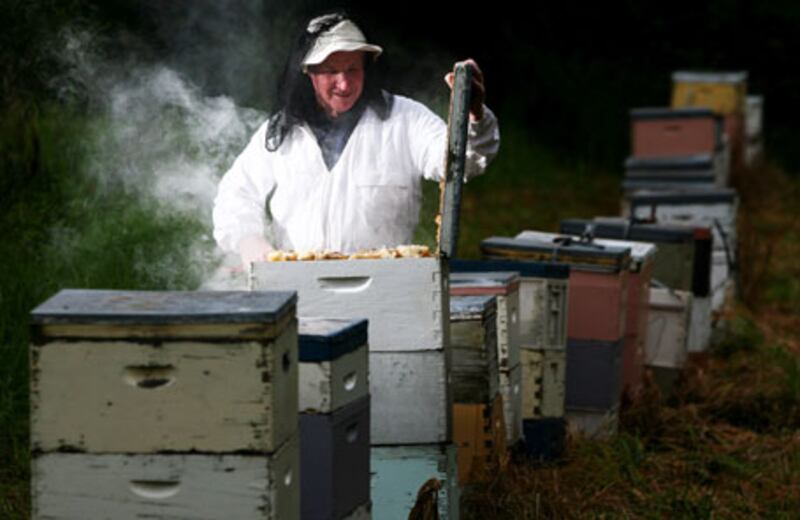SYDNEY // Australian scientists have discovered that honey is a powerful natural medicine capable of killing almost all types of bacteria, including drug-resistant superbugs that threaten the lives of hospital patients around the world. The miracle sweet liquid is Manuka or jelly bush honey and is made only by bees collecting pollen and nectar from trees in Australia and New Zealand. After seven years of research, a team at the University of Sydney has found that this simple product has an extraordinary ability to destroy micro-organisms that cause infections in external wounds.
"The bacteria have all been killed very quickly by honey, despite any resistance [to other drugs] that they might have," said Dee Carter, an associate professor. The hope is that sterilised honey-based formulas will be able to replace antibiotic and antiseptic creams in the treatment of cuts, burns, insect bites and other skin diseases. Experiments have shown that even the potentially deadly bacterium methicillin-resistant staphylococcus aureus, which can repel certain antibiotics, has been no match for Manuka honey.
"MRSA, which is the organism that commonly colonises catheters, gets into people's bloodstreams and causes very serious infections in hospitals. This one is interesting because it is highly susceptible to honey, which will kill it outright," Mrs Carter said. The magic ingredient is a mysterious active substance that continues to baffle experts because inexplicably it only seems to attack pathogens but nothing else.
"It has a special compound in it called methylglyoxal, which makes it very toxic to bacteria. In theory, this should make it toxic to humans as well but it is not, so it has other things in there as well that seem to both promote its toxicity to the bacteria and prevent it being toxic to human cells," Mrs Carter said. Past studies overseas have suggested that methylglyoxal may damage healthy genes and chromosomes, which could potentially cause cancer or complications for patients with diabetes.
Researchers at the University of Sydney, however, are convinced that further testing will deliver incontrovertible proof of the exceptional healing qualities of this type of honey. "We need the science behind our claims and that is what we are doing," Mrs Carter said. "Obviously they [doctors] don't want to hear something that just sounds like a folk remedy. They want to hear something that's got scientific validation. We think eventually they'll come round with a bit more work."
Throughout history, honey has been venerated for its medicinal properties and was used by the ancient Egyptians as well as by aboriginal cultures around the world to treat wounds. Although its therapeutic value is understood now more than ever, some of its scientific secrets remain unsolved. "Way back it was known that honey had some antibiotic properties, but the reason why has never been completely identified. Some floral types have more antibiotic activity than others," said Bruce White, a veteran beekeeper and former technical specialist at the New South Wales department of primary industry. "The activity is not there all the time. Some seasons the honey is quite active, other seasons it's not and there is no reason we can find out why."
Manuka honey is abundant in New Zealand, while in neighbouring Australia it is harvested in large quantities on the island state of Tasmania. About half of Australia's beekeeping industry is found further north in New South Wales, where Mr White, an amateur enthusiast, owns 200 hives that each contain up to 100,000 insects during the warm summer months. He said bees were an immense force of nature: "People take them for granted. The biggest benefit from bees is pollination. If we didn't have bees we would probably starve because so many plants require cross-pollination and honey bees are the most effective insect at this.
"A bee hive is really like a giant factory. You can use the bees to pollinate crops, to produce beeswax, honey, and venom, too, to treat people who are allergic to bee stings," Mr White added. It may also be used in cancer treatments. Other researchers believe honey's curative values go beyond the treatment of wounds and other skin ailments. They have analysed the golden liquid's pro-biotic qualities, where some of its carbohydrates are broken down in the small intestine while the rest passes undigested into the large bowel.
"What happens with these long-chain sugars [carbohydrates], they stimulate the growth of healthy bacteria in your bowel and help to prevent the toxins that build up," said Rosie Stern, a Sydney food scientist and clinical dietician. "So, it actually prevents bowel cancer, irritable bowel syndrome, Crohn's disease and ulcerative colitis - all these modern-day diseases we have in our large intestine."
As further tests are carried out to confirm Manuka honey's status as a powerful natural remedy, Mrs Carter has experienced first-hand its remarkable healing ability. "I cut my finger recently - quite a nasty cut on the inside of my finger. I put honey on and dressed it, but it was pretty much gone in a couple of days. It was quite astounding." pmercer@thenational.ae





